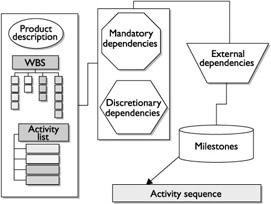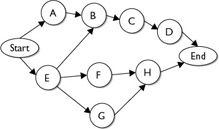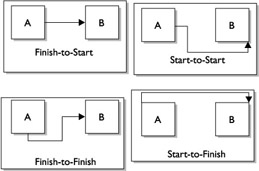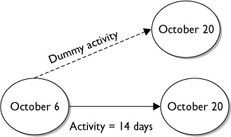Mapping the Activities
|
| < Day Day Up > |
|
Now that the activity list has been created, the activities must be arranged in a logical sequence. This process calls on the project manager and the project team to identify the logical relationships between activities-and the preferred relationship between activities. This can be accomplished a few different ways:
-
Computer driven There are many different scheduling and project management software packages available. These programs can help the project manager and the project team determine which actions need to happen in what order-and with what level of discretion.
-
Manual process In smaller projects, and on larger projects in the early phases, manual sequencing may be preferred. An advantage of manual sequencing is that it's easier to move around dependencies and activities than in some programs.
-
Blended approach A combination of manual and computer-driven scheduling methods is fine. It's important to determine the finality of the activity sequence, however. Sometimes a blended approach can be more complex than relying on just one or another.
| On the Job | 'Sticky notes' can help sequence events. Put your activities on sticky notes and then plot them out on a white board. Draw arrows to show the relationship between activities. Want to make a change? It's easy to rearrange the notes and the relationships. |
Considering the Inputs to Activity Sequencing
Figure 6-3 shows the complete process of activity sequencing. There are many approaches to completing the activity sequencing. Perhaps the greatest approach, however, is that activity sequencing is done with the project team, not as a solo activity.

Figure 6-3: Activity sequencing relies on inputs to create the final sequence of events.
The project manager must rely on the project team and the inputs to activity sequencing:
-
Activity list The activity list we've just discussed-it's the list of actions needed to complete the project deliverables.
-
Product description The product description is needed since it may influence the sequence of events. For example, in construction, technology, or community planning (among other project types), the product description may include requirements that will logically affect the planning of activity sequencing.
-
Mandatory dependencies These dependencies are the natural order of activities. For example, you cannot begin building your house until your foundation is in place. These relationships are called hard logic.
-
Discretionary dependencies These dependencies are the preferred order of activities. Project managers should use these relationships at their 'discretion' and document the logic behind the decision. Discretionary dependencies allow activities to happen in a preferred order because of best practices, conditions unique to the project work, or external events. For example, a painting project typically allows the primer and the paint to be applied within hours of each other. Due to the expected high humidity during the project, however, all of the building will be completely primed before the paint can be applied. These relationships are also known as soft logic, preferred logic, or preferential logic.
-
External dependencies As its name implies, these are dependencies outside of the project's control. Examples include delivery of equipment from a vendor, the deliverable of another project, or the decision of a committee, lawsuit, or expected new law.
-
Milestones Milestones must be considered and evaluated when sequencing events to ensure all of the work needed to complete the milestones is included.
Creating Network Diagrams
Network diagrams visualize the project work. A network diagram shows the relationship of the work activities and how the work will progress from start to completion. Network diagrams can be extremely complex or easy to create and configure. Most network diagrams in today's project management environment use an approach called 'activity-on-node' to illustrate the activities and the relationship between activities. Older network diagramming methods used 'activity-on-arrows' to represent the activities and their relationships.
Using the Precedence Diagramming Method
The Precedence Diagramming Method (PDM) is the most common method of arranging the project work visually. The PDM puts the activities in boxes, called nodes, and connects the boxes with arrows. The arrows represent the relationship and the dependencies of the work packages. The following illustration shows a simple network diagram using PDM.

Exam Watch
PDM is also known as AON- activity-on-node. It's the most common approach to network diagramming since it's used by most project management information systems but can also be done manually.
Relationships between activities in a PDM constitute one of four different types (as shown in Figure 6-4):

Figure 6-4: PDM relationships can vary, but most use the finish-to-start approach.
-
Finish-to-start (FS) This relationship means Task A must complete before Task B can begin. This is the most common relationship. Example: The foundation must be set before the framing can begin.
-
Start-to-start (SS) This relationship means Task A must start before Task B can start. This relationship allows both activities to happen in tandem. For example, a crew of painters is painting a house. Task A is to scrape the flecking paint off the house and Task B is to prime the house. The workers scraping the house must start before the other workers can begin priming the house. All of the scraping doesn't have to be completed before the priming can start, just some of it.
-
Finish-to-finish (FF) This relationship means Task A must complete before Task B does. Ideally, two tasks must finish at exactly the same time, but this is not always the case. For example, two teams of electricians may be working together to install new telephone cables throughout a building by Monday morning. Team A is pulling the cable to each office. Team B is connecting the cables to wall jacks and connecting the telephones. Team A must pull the cable to the office so Team B can complete their activity. The activities need to complete at nearly the same time, by Monday morning, so the new phones are functional.
-
Start-to-finish (SF) This relationship is unusual and is rarely used. It requires that Task A start so that Task B may finish. Such relationships may be encountered in construction and manufacturing. It is also known as just-in-time (JIT) scheduling. An example is a construction of a shoe store. The end of the construction is soon, but an exact date is not known. The owner of the shoe store doesn't want to order the shoe inventory until the completion of the construction is nearly complete. The start of the construction tasks dictates when the inventory of the shoes is ordered.
Using the Arrow Diagramming Method
The Arrow Diagramming Method (ADM) approach to activity sequencing uses arrows to represent the activities. The arrows are 'connected' on nodes. ADM only uses finish-to-start relationships. In some instances, dummy activities are required to express the logical relationship between two activities. A dummy activity is illustrated with a dashed arrow between the nodes. The following illustration is a simple example of an ADM network diagram.
Exam Watch
Only professional scheduling engineers should use the SS, FF, and SF relationships. Don't worry about the SF for your exam studying time; you likely won't encounter it.
ADM is an example of activity-on-arrow (AOA) networks. This approach is not as popular as PDM, but may still be prevalent in some industries. ADM can be created manually or through a PMIS.

Using Conditional Diagramming Methods
Conditional diagramming methods are more complex and structured than ADM or PDM. Conditional diagramming methods include system dynamics and the graphical evaluation and review technique (GERT). These models allow for loops and conditional branching. For example, GERT may require that tests of the product be performed several times before the project may continue. Based on the outcome of the testing, the project may use one of several paths to enable its completion. In addition, GERT allows for probabilistic clarification of work package estimates.
Utilizing Network Templates
Just as a project manager can rely on WBS templates, there may be network templates available to streamline the planning process or to conform to a predetermined standard. Network templates can represent an entire project if appropriate, though portions of a network template, such as the required project management activities, are common.
Exam Watch
Note that GERT allows for conditional advancement. ADM and PDM offer no loops or branching.
The portions of a network template are also known as subnets or fragnets. Subnets are often associated with repetitive actions within a network diagram. For example, each floor in a high-rise apartment building may undergo the same or similar actions during construction. Rather than complete the network diagram for each floor, a subnet can be implemented.
|
| < Day Day Up > |
|
EAN: 2147483647
Pages: 209